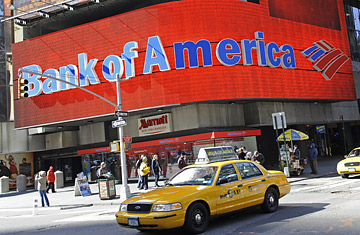
A branch of the Bank of America branch in New York
The latest way for the government to decide what it should do with troubled banks is to put them though what it calls a "stress test". The criteria that will be used, among others, is how a bank will do if unemployment rises to 10% and housing prices drop another 25%. Those conducting the tests don't think the economy will get that bad, but they plan to set the bar as high as possible.
A number of banks being put through the system probably will not make the grade. These will have to raise more capital. Since private money is not abundant, the cash will come from the government and that means the U.S. will end up owning significant pieces of the largest banks. It may be able to sell those interests back into the private market at some point in the distant future. The taxpayer could even end up with a profit, but it never works that way. The money gets diverted by a Senator who needs to build a damn in Oregon to keep his job. (See what businesses are doing well despite the recession.)
Putting banks through a series of "war games" will not work for the same reason that they do not work well for the military. The officers who set up the games do not have any imagination. They use past experience to determine what it likely to happen in the future. The next time a real conflict comes along, all that soldiers have learned from their training is how to keep their weapons clean and give out their name, rank and serial number.
The one thing that all financial calamities have in common is that they are unexpected, at least by the officials who are supposed to keep an eye out for these things. There were no plans for oil prices to spike up before the Arab Oil Embargo in the 1970s and no roadmap to follow after the S&L crisis the following decade. Banks can be brought down by fraud and errors in large gambles made on proprietary trading desks. Most of the things that cause systemic failure are unexpected and therefore cannot be prevented.
If it is the government's goal to preserve the private banks as private banks and keep losses to a minimum, the test should go beyond looking at what is likely to happen and focus more on the things that are not predictable. It may require hiring PhDs in chaos theory, but the recession has put a lot of these people out of work.
On a scale of 1 to 10, with 10 being a bank in perfect condition, Citigroup may end up with a 2 on its stress test. The government will require it to take more taxpayer capital and the firm may then have ample reserves. Wells Fargo (WFC) could achieve a grade of 8 and then not need to take any financial support from the Treasury. Wells Fargo's shareholders then benefit because their shares are not diluted.
Only part of the bank risk problem is solved by evaluating mundane factors such as the strengths of bank balance sheets and forecasts of a more dire economic future. Regulators have created a bell shaped curve for bank risk based on too few variables.
The Federal government could not have imagined that the defaults on sovereign debt from countries in South America would make Citibank technically insolvent in the 80's. But it happened anyway.
— Douglas A. McIntyre
See 25 people to blame for the financial crisis.
For constant business updates, go to 24/7wallst.com.
